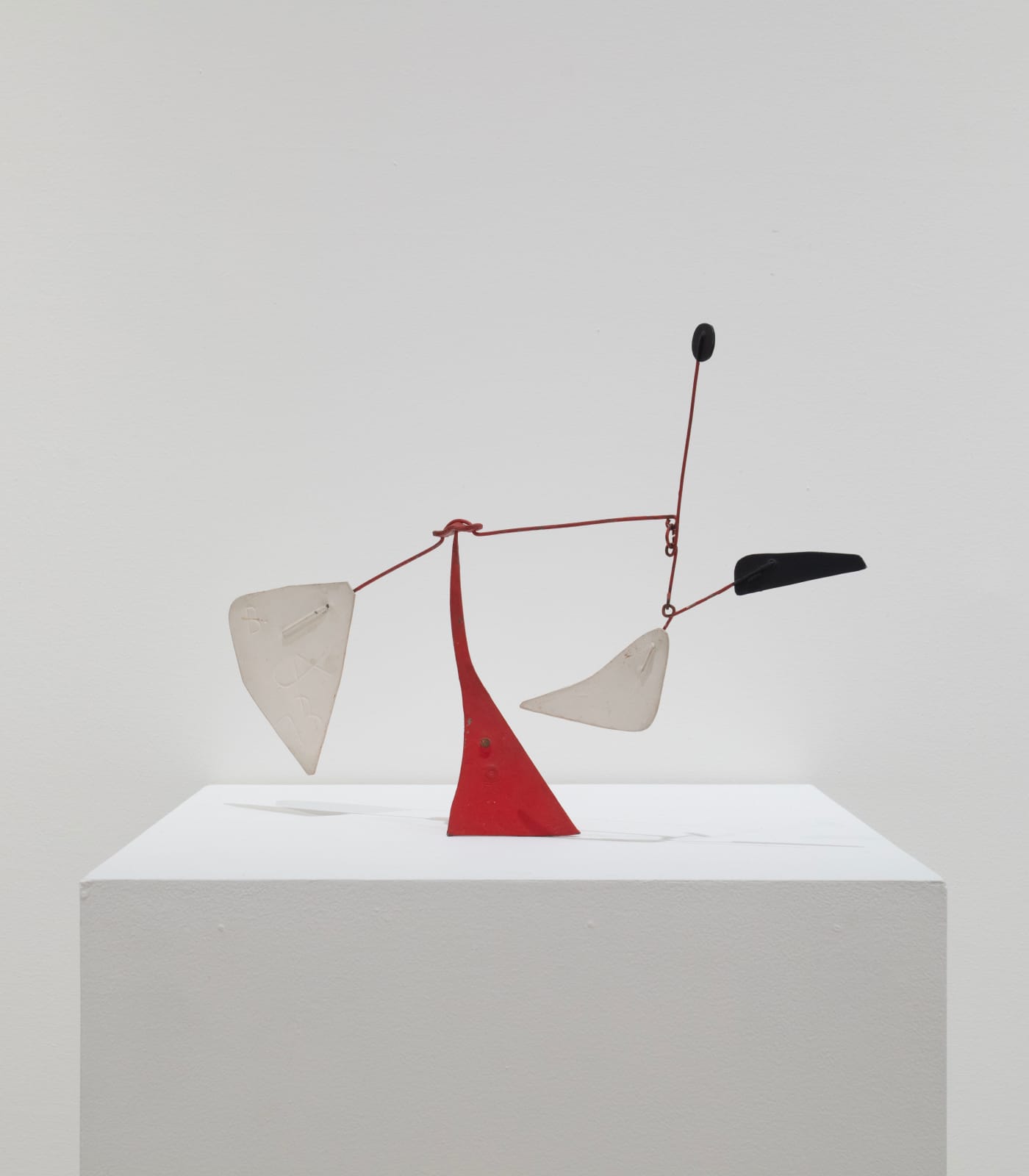
Alexander Calder American, 1898-1976
B is for Barney, 1973
Steel stabile with red base, two white elements and two black elements
30.5 x 35.6 x 15.2 cm. (12 x 14 x 6 in.)
Copyright The Artist
Further images
Alexander Calder’s B is for Barney is a compelling example of his innovative synthesis of form and movement, executed at the height of the artist's career, exemplifying Calder’s ability to...
Alexander Calder’s B is for Barney is a compelling example of his innovative synthesis of form and movement, executed at the height of the artist's career, exemplifying Calder’s ability to balance playfulness and engineering mastery. Comprised of a vibrant red base, the work features a delicate wire armature that suspends a white, sheet-metal petal counterbalanced with a hanging a mobile element composed of three disc-like forms, which oscillate in response to the surrounding air, imparting a sense of perpetual animation. Gifted by Calder to Barnett Owen, a close friend and director at the Perls Gallery, B is for Barney remained in Owen’s collection until 1993. The friendship between artist and gallerist was a testament to the tight-knit relationships within Calder’s creative circle, and the personal nature of this gift imbues the work with additional historical resonance.
Calder’s groundbreaking journey into kinetic art began in 1931, when he started creating sculptures featuring bold, geometric shapes painted in primary colours and suspended by wire. These early pieces, powered by motors or manual cranks, evolved into what Marcel Duchamp famously christened ‘mobiles’ – a term encapsulating both ‘motion’ and ‘motive’ in French. These works were revolutionary, not merely depicting motion but embodying it. Calder bridged the aesthetics of Dada and Futurism, imbuing his sculptures with the playful dynamism of the early 20th-century avant-garde. Simultaneously, Calder developed his ‘stabiles,’ a term coined by Jean Arp in 1932 to describe the artist’s stationary, non-motorised constructions. Unlike their mobile counterparts, stabiles explored spatial relationships, balance, and the subtle tensions between gravity and form. While mobiles captured the delicacy of shifting air and the ephemerality of movement, stabiles embodied strength and equilibrium. Yet even in their stillness, they radiated a latent energy, as though anticipating motion at any moment.
B is for Barney marries both traditions. Its stabile base provides structure and rootedness, while the mobile element introduces kinetic potential, creating a harmonious dialogue between stillness and movement. This duality – so central to Calder’s practice – underscores his mastery of balance, whether physical, visual, or conceptual. In this diminutive yet dynamic work, Calder’s enduring spirit of innovation and joyful exploration of form are on full display.
Calder’s groundbreaking journey into kinetic art began in 1931, when he started creating sculptures featuring bold, geometric shapes painted in primary colours and suspended by wire. These early pieces, powered by motors or manual cranks, evolved into what Marcel Duchamp famously christened ‘mobiles’ – a term encapsulating both ‘motion’ and ‘motive’ in French. These works were revolutionary, not merely depicting motion but embodying it. Calder bridged the aesthetics of Dada and Futurism, imbuing his sculptures with the playful dynamism of the early 20th-century avant-garde. Simultaneously, Calder developed his ‘stabiles,’ a term coined by Jean Arp in 1932 to describe the artist’s stationary, non-motorised constructions. Unlike their mobile counterparts, stabiles explored spatial relationships, balance, and the subtle tensions between gravity and form. While mobiles captured the delicacy of shifting air and the ephemerality of movement, stabiles embodied strength and equilibrium. Yet even in their stillness, they radiated a latent energy, as though anticipating motion at any moment.
B is for Barney marries both traditions. Its stabile base provides structure and rootedness, while the mobile element introduces kinetic potential, creating a harmonious dialogue between stillness and movement. This duality – so central to Calder’s practice – underscores his mastery of balance, whether physical, visual, or conceptual. In this diminutive yet dynamic work, Calder’s enduring spirit of innovation and joyful exploration of form are on full display.
